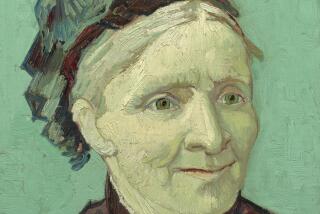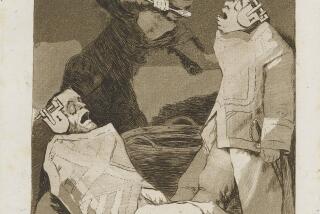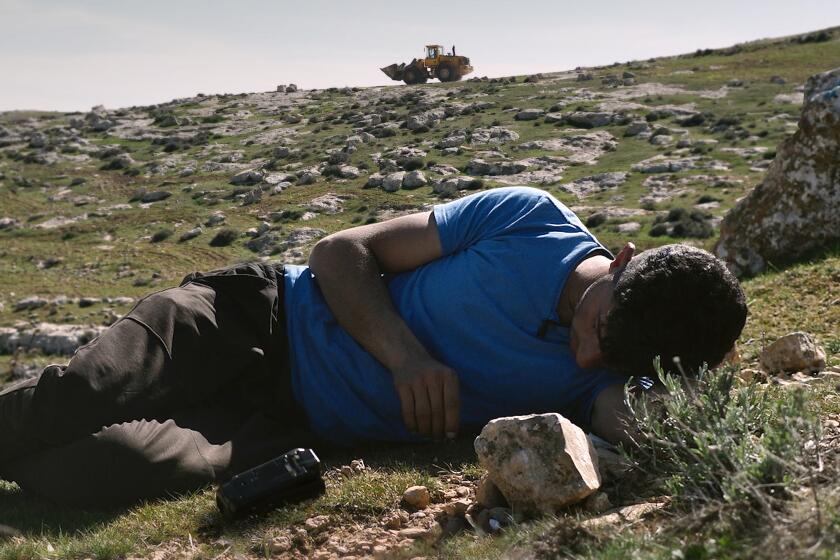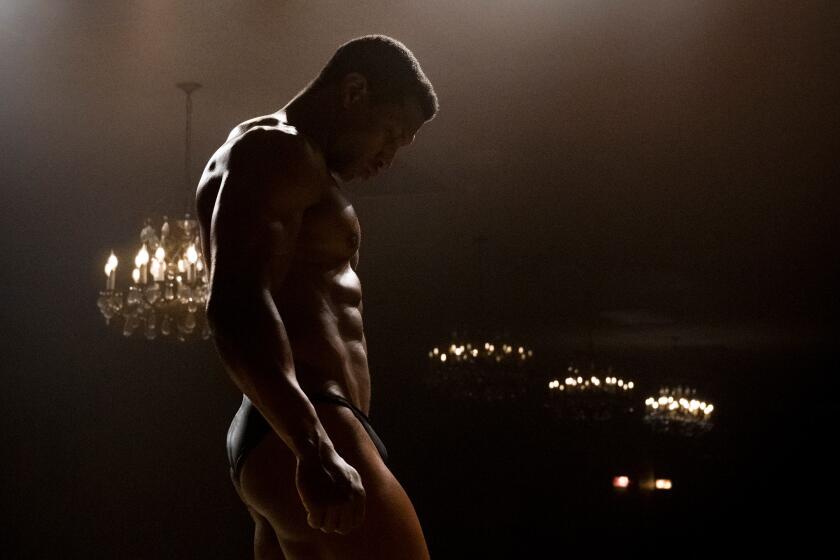
- Share via
If you think you’ve never seen a painting by Thomas Kinkade, think again. The late artist, who is said to have sold more canvases than any painter in history, created a cottage industry (pun intended) of ubiquitous, mass-produced art with his blissful landscapes, idyllic street scenes and cozy cottage tableaus. But the beatific, charismatic painter, who developed a rock-star following, was not all that he seemed.
Miranda Yousef, in her feature directing debut, deftly takes on Kinkade’s timely and intriguing story in the documentary “Art for Everybody,” an absorbing, smartly assembled portrait of the mega rise and tragic fall of the Jekyll-and-Hyde-like artist.
Kinkade’s enormous 1990s-era success, which saw his work reproduced on everything from collectible plates to La-Z-Boy loungers, dovetailed with the period’s culture war against the sexualization of art. The born-again Kinkade stepped into that breach, doubled down on the family values bit and became known as a creator of images that the Christian community, among other groups, could embrace. But how much of this was opportunism and how much was true belief?
Yousef, who also edited the film, vividly dissects the artist’s complicated life with the help of strong archival and personal footage as well as candid interviews with family members, colleagues and a solid array of art-world figures.
Thomas Kinkade dies at 54; ‘Painter of Light’ worked to project ‘serene simplicity’
She first tracks Kinkade from his impoverished Placerville, Calif., youth to his late-1970s days as a bohemian art student at UC Berkeley and Pasadena’s ArtCenter College of Design, followed by his work as a background artist for Ralph Bakshi’s 1983 animated fantasy “Fire and Ice.” (Bakshi, now 86, enthuses here about Kinkade’s talent and work ethic.)
Kinkade’s nascent pieces were often dark and provocative. But it was his move into painting — specifically his signature bucolic pastels with their near-heavenly lighted windows and skies — that would lead him and business partner Ken Raasch to create an art empire that, at its peak, reportedly brought in more than $100 million in annual sales. Kinkade’s eponymous mall stores and QVC appearances were among his many lucrative outlets. He was dubbed the “Painter of Light,” even though British artist J.M.W. Turner first claimed that title in the early 1800s.
But from a sheer artistic point of view, was Kinkade’s work any good? Or was it simply middlebrow kitsch?
Los Angeles Times art critic Christopher Knight, who offers several unvarnished opinions here, asserts that Kinkade “had a quite outsized cultural impact with really bad art.” Of his famed cottage paintings, Knight calls them “a cliché piled upon a fantasy piled upon a bad idea. That cottage is where the Wicked Witch lives… I’m not going in there.”
Journalist and author Susan Orlean (“The Orchid Thief”), who profiled Kinkade for a 2001 New Yorker article that lends this documentary its title, considers his output “very sentimental, a little garish and kind of twee,” despite its admittedly broad appeal.
Yet Kinkade, often seen in the film’s clips as confident and ebullient with a kind of evangelist’s fervor, pushes back against the naysayers by contending, “All great art is not about art — all great art is about life.” And he took that belief to the bank, literally.
We’ve mapped out 27 of the best movie theaters in L.A., from the TCL Chinese and the New Beverly to the Alamo Drafthouse and which AMC reigns in Burbank.
But it’s recent interviews with Kinkade’s wife, Nanette (they married in 1982), and their four millennial daughters — Merritt, Chandler, Winsor and Everett — that provide the doc’s emotional heft and shed valuable light on the tumultuous man behind the serene paintings.
Yousef masterfully carries us along from the women’s happier memories of Kinkade as a devoted family man to someone whose work and fame began to supplant the needs of his wife and kids. His family says he could be “manic” and “hard to connect with” and, from a few behind-the-scenes clips of Kinkade at promotional events, he seemed to treat his then-small daughters like props for the cameras. In addition, the artist comes off as smarmy and contentious at times, belying his “holy man” persona and populist vibe.
From around 2006 to 2010, a series of major business downturns, including a bankruptcy filing and several key lawsuits, led Kinkade into a downward spiral of troubling public behavior and substance abuse. (Footage showing Kinkade’s compulsive need for booze is unsettling.) His family, angry and fearful, even staged an intervention to force the former teetotaler into rehab. Though he reluctantly went, the therapy didn’t take. He died in 2012, at age 54, from an accidental overdose of alcohol and Valium.
Ultimately, the centerpiece of the film is the Kinkade daughters’ posthumous discovery of a vault that houses a trove of their father’s unseen, artistically challenging work, much of which shows an underside that few people knew — or could have ever imagined. The women’s reexamination of their complex dad’s demons and flaws, vis-à-vis these unearthed creations, proves illuminating and poignant.
Among the doc’s other interview subjects are former Times investigative reporter Kim Christensen, who wrote several articles about Kinkade’s legal troubles, which included art gallery fraud; Kinkade’s college girlfriend, who recalls his sometimes hostile, dualistic nature; and artist Jeffrey Vallance, who curated the only major survey exhibition of Kinkade’s work, held in 2004 at Cal State Fullerton’s Grand Central Art Center.
'Art for Everybody'
Not rated
Running time: 1 hour, 39 minutes
Playing: In limited release Friday, April 18
More to Read
Only good movies
Get the Indie Focus newsletter, Mark Olsen's weekly guide to the world of cinema.
You may occasionally receive promotional content from the Los Angeles Times.











